Composition of Pre-Salt Siliciclastic Units of the Lower Congo Basin and Paleogeographic Implications for the Early Stages of Opening of the South Atlantic
Abstract
1. Introduction
2. Geological Setting
2.1. The LCB and the Opening of the South Atlantic
2.2. Basement of the LCB
2.3. Stratigraphy of the LCB
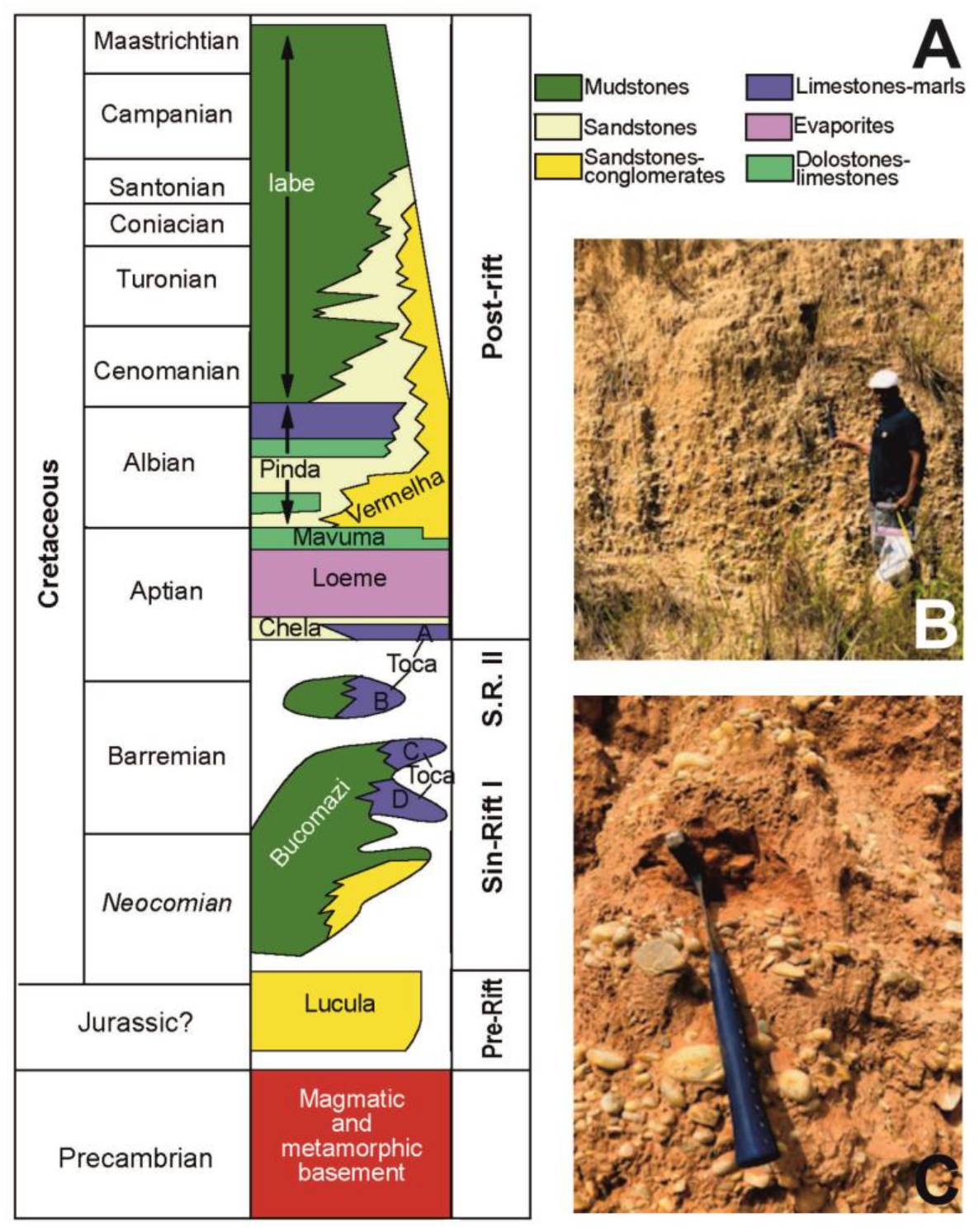
3. Materials and Methods
3.1. Studied Samples
3.2. Geochemistry
3.3. XRD Mineralogy
3.4. Heavy Minerals
3.5. Data Treatment
4. Results
4.1. Mineralogy
4.2. Geochemistry
5. Discussion
5.1. Source Units During South Atlantic Opening
5.2. Weathering, Recycling and Diagenesis
5.3. Paleogeographic Implications
6. Conclusions
Supplementary Materials
Author Contributions
Funding
Data Availability Statement
Acknowledgments
Conflicts of Interest
References
- USGS World Petroleum Assessment 2000. New Estimates of Undiscovered Oil and Natural Gas, Natural Gas Liquids, Including Reserve Growth, Outside the United States; USGS Publications Warehouse: Reston, VA, USA, 2003; p. 062-03. [Google Scholar]
- Lehner, P.; De Ritter, P.A.C. Structural history of Atlantic margin of Africa. AAPG Bull. 1977, 61, 961–981. [Google Scholar]
- Konyukhov, A.I. Pericontinental petroliferous basins of the South Atlantic Ocean. Lithol. Miner. Resour. 2008, 43, 203–219. [Google Scholar] [CrossRef]
- Marcano, G.; Anka, Z.; di Primio, R. Major controlling factors on hydrocarbon generation and leakage in South Atlantic conjugate margins: A comparative study of Colorado, Orange, Campos and Lower Congo basins. Tectonophysics 2013, 604, 172–190. [Google Scholar] [CrossRef]
- Karner, G.D.; Driscoll, N.W. Tectonic and stratigraphic development of the West African and eastern Brazilian margins; insights from quantitative basin modelling. In The Oil and Gas Habitats of the South Atlantic; Cameron, N.R., Clure, V.S., Eds.; Geological Society Special Publications: London, UK, 1999; Volume 153, pp. 11–40. [Google Scholar]
- Lentini, M.R.; Fraser, S.I.; Sumner, H.S.; Davies, R.J. Geodynamics of the central South Atlantic conjugate margins; implications for hydrocarbon potential. Pet. Geosci. 2010, 16, 217–229. [Google Scholar] [CrossRef]
- Szatmari, P.; Milani, E.J. Tectonic control of the oil-rich large igneous-carbonate-salt province of the South Atlantic rift. Mar. Pet. Geol. 2016, 77, 567–596. [Google Scholar] [CrossRef]
- Tack, L.; Wingate, M.T.D.; Liégeois, J.P.; Fernandez-Alonso, M.; Deblond, A. Early Neoproterozoic magmatism (1000–910 Ma) of the Zadinian and Mayumbian Groups (Bas-Congo): Onset of Rodinia rifting at the western edge of the Congo craton. Precambrian Res. 2001, 110, 277–306. [Google Scholar] [CrossRef]
- Moulin, M.; Aslanian, D.; Olivet, J.; Contrucci, I.; Matias, L.; Geli, L.; Klingelhoefer, F.; Nouze, H.; Rabineau, M.; Labails, C.; et al. Geological constraints on the evolution of the Angolan margin based on reflection and refraction seismic data (ZaiAngo Project). Geophys. J. Int. 2005, 162, 793–810. [Google Scholar] [CrossRef]
- Chaboureau, A.-C.; Donnadieu, Y.; Sepulchre, P.; Robin, C.; Guillocheau, F.; Rohais, S. The South Atlantic Aptian evaporites: A climatic paradox? Clim. Past 2012, 8, 1047–1058. [Google Scholar] [CrossRef]
- Moulin, M.; Aslanian, D.; Unternehr, P. A new starting point for the South and Equatorial Atlantic Ocean. Earth-Sci. Rev. 2010, 98, 1–37. [Google Scholar] [CrossRef]
- Scotese, C.R.; Vérard, C.; Burgener, L.; Elling, R.P.; Kocsis, A.T. The Cretaceous World: Plate Tectonics, Palaeogeography, and Palaeoclimate. Geol. Soc. Lond. Spec. Publ. 2025, 544, SP544-2024. [Google Scholar] [CrossRef]
- Renne, P.R.; Ernesto, M.; Pacca, I.G.; Coe, R.S.; Glen, J.M.; Prevot, M.; Perrin, M. The age of Parana flood volcanism, rifting of Gondwanaland, and the Jurassic- Cretaceous boundary. Science 1992, 258, 975–979. [Google Scholar] [CrossRef]
- Florisbal, L.M.; Bitencourt, M.F.; Janasi, V.A.; Nardi, L.V.S.; Heaman, L.M. Petrogenesis of syntectonic granites emplaced at the transition from thrust to strike-slip tectonics in a post-collisional setting: Whole-rock geochemistry and Sr-Nd-Pb isotopes in the Neoproterozoic Quatro Ilhas and Mariscal granites, Southern Brazil. Lithos 2012, 153, 5–371. [Google Scholar] [CrossRef]
- Behar, F.; Delhaye-Prat, V.; Garel, S. Detrital input quantification in lacustrine petroleum systems: An example of the pre-salt source rocks from the Lower Congo Basin (Congo). Depos. Rec. 2021, 7, 147–171. [Google Scholar] [CrossRef]
- Pedrosa-Soares, A.C.; Noce, C.M.; Wiedemann-Leonardos, C.M.; Pinto, C.P. The Aracuaí–West Congo orogen in Brazil: An overview of a confined orogen formed during Gondwanland assembly. Precambrian Res. 2001, 110, 307–323. [Google Scholar] [CrossRef]
- Alkmim, F.F.; Marshak, S.; Pedrosa-Soares, A.C.; Peres, G.G.; Cruz, S.C.; Whittington, A. Kinematic evolution of the Araçuaí–West Congo orogen in Brazil and Africa: Nutcracker tectonics during the Neoproterozoic assembly of Gondwana. Precambrian Res. 2006, 149, 43–63. [Google Scholar] [CrossRef]
- Kuchenbecker, M.; Barbuena, D. Basement inliers of the Araçuaí- West Congo orogen: Key pieces for understanding the evolution of the São Francisco-Congo paleocontinent. J. South Am. Earth Sci. 2023, 125, 104299. [Google Scholar] [CrossRef]
- Franssen, L.; André, L. The Zadinian Group (late Proterozoic, Zaıre) and its bearing on the origin of the West-Congo orogenic belt. Prec. Res. 1988, 38, 215–234. [Google Scholar] [CrossRef]
- Noce, C.M.; Pedrosa-Soares, A.C.; da Silva, L.C.; Armstrong, R.; Piuzana, D. Evolution of polycyclic basement complexes in the Araçuaí Orogen, based on U–Pb SHRIMP data: Implications for Brazil–Africa links in Paleoproterozoic time. Precambrian Res. 2007, 159, 60–78. [Google Scholar] [CrossRef]
- Boudzoumou, F.; Trompette, R. La chaine panafricaine ouest-congolienne au Congo (Afrique equatoriale); un socle polycyclique charrie sur un domaine subautochtone forme par l’aulacogene du Mayombe et le bassin de l’Ouest-Congo. Bull. Soc. Géol. Fr. 1988, 4, 889–896. [Google Scholar] [CrossRef]
- Frimmel, H.E.; Tack, L.; Basei, M.S.; Nutman, A.P.; Boven, A. Provenance and chemostratigraphy of the Neoproterozoïc West Congolian Group in the Democratic Republic of Congo. J. Afr. Earth Sci. 2006, 46, 221–239. [Google Scholar] [CrossRef]
- McHargue, T.R. Stratigraphic development of proto-South Atlantic rifting in Cabinda, Angola—A petroliferous lake basin. In Lacustrine Basin Exploration Case Studies and Modern Analogs; Katz, B.J., Ed.; AAPG Memoir: McLean, VA, USA, 1990; Volume 50, pp. 307–326. [Google Scholar]
- Burwood, R.; De Witte, S.M.; Mycke, B.; Paulet, J. Petroleum Geochemical Characterisation of the Lower Congo Coastal Basin Bucomazi Formation. In Petroleum Source Rocks; Katz, B.J., Ed.; Casebooks in Earth Sciences; Springer: Berlin, Heidelberg, 1995; pp. 235–263. [Google Scholar]
- Burwood, R. Angola: Source rock control for Lower Congo coastal and Kwanza Basin petroleum systems. In The Oil and Gas Habitat of the South Atlantic; Cameron, N., Bate, R.H., Clure, V., Eds.; Geological Society of London Special Publication: London, UK, 1999; pp. 181–194. [Google Scholar]
- Braccini, E.M.; Denison, C.N.; Scheevel, J.R.; Jeronimo, P.; Orsolini, P.; Barletta, V. A revised chrono-lithostratigraphic framework for the pre-salt (Lower Cretaceous) in Cabinda, Angola. Bull. Cent. Rech. Explor. Prod. Elf 1997, 21, 125–151. [Google Scholar]
- Cole, G.A.; Requejo, A.G.; Ormerod, D.; Yu, Z.; Clifford, A. Petroleum Geochemical Assessment of the Lower Congo Basin. AAPG Mem. 2000, 73, 325–339. [Google Scholar]
- Da Costa, J.L.; Schirmer, T.W.; Laws, B.R. Lower Congo Basin, deep-water exploration province, offshore West Africa. AAPG Mem. 2001, 74, 517–530. [Google Scholar]
- Uchupi, E. The tectonic style of the Atlantic Mesozoic rift system. J. Afr. Earth Sci. 1989, 8, 143–164. [Google Scholar] [CrossRef]
- Schlumberger WEC. Basin Geology. Congo Basin. Well Evaluation Conference. Angola 1991, 1st ed.; Galilée: Paris, France, 1991; pp. I-28–I-65. [Google Scholar]
- Binks, R.M.; Fairhead, J.D. A plate tectonic setting for Mesozoic rifts of west and central Africa. Tectonophysics 1992, 213, 141–151. [Google Scholar] [CrossRef]
- Guiraud, R.; Maurin, J.-C. Early Cretaceous rifts of western and central Africa—An overview. Tectonophysics 1992, 213, 153–168. [Google Scholar] [CrossRef]
- Bracken, B.R. Syn-rift lacustrine beach and deltaic sandstone reservoirs—Pre-salt (Lower Cretaceous) of Cabinda, Angola, west Africa. In Lacustrine Reservoirs and Depositional Systems; Lomando, A.J., Schreiber, B.C., Harris, P.M., Eds.; SEPM Core Workshop: Tulsa, OK, USA, 1994; Volume 19, pp. 173–200. [Google Scholar]
- Burwood, R.; Cornet, P.J.; Jacobs, L.; Paulet, J. Organofacies variation control on hydrocarbon generation: A Lower Congo coastal basin (Angola) case history. Org. Geochem. 1990, 16, 325–338. [Google Scholar] [CrossRef]
- Folk, R.L.; Ward, W.C. Brazos River bar: A study in the significance of grain size parameters. J. Sedim. Petrol. 1957, 27, 3–26. [Google Scholar] [CrossRef]
- Conrey, R.M.; Goodman-Elgar, M.; Bettencourt, N.; Seyfarth, A.; Van Hoose, A.; Wolff, J.A. Calibration of a portable X-ray fluorescence spectrometer in the analysis of archaeological samples using influence coefficients. Geochem. Explor. Environ. Anal. 2014, 14, 291–301. [Google Scholar] [CrossRef]
- Williams, R.; Taylor, G.; Orr, C. pXRF method development for elemental analysis of archaeological soil. Archaeometry 2020, 62, 1145–1163. [Google Scholar] [CrossRef]
- Aitchison, J. The Statistical Analysis of Compositional Data; Chapman & Hall: London, UK, 1986. [Google Scholar]
- Rudnick, R.L.; Gao, S. Composition of the continental crust. In Treatise on Geochemistry, Vol. 3; Rudnick, R.L., Holland, H.D., Turekian, K.K., Eds.; The Crust; Elsevier: Amsterdam, The Netherlands, 2003; pp. 1–64. [Google Scholar]
- Hu, Z.; Gao, S. Upper crustal abundances of trace elements: A revision and update. Chem. Geol. 2008, 253, 205–221. [Google Scholar] [CrossRef]
- von Eynatten, H.; Barcelo-Vidal, C.; Pawlowsky-Glahn, V. Composition and discrimination of sandstones: A statistical evaluation of different analytical methods. J. Sediment. Res. 2003, 73, 47–57. [Google Scholar] [CrossRef]
- López, J.M.G.; Bauluz, B.; Fernández-Nieto, C.; Oliete, A.Y. Factors controlling the trace-element distribution in fine-grained rocks: The Albian kaolinite-rich deposits of the Oliete Basin (NE Spain). Chem. Geol. 2005, 214, 1–19. [Google Scholar] [CrossRef]
- Pe-Piper, G.; Triantafyllidis, S.; Piper, D.J. Geochemical identification of clastic sediment provenance from known sources of similar geology: The Cretaceous Scotian Basin, Canada. J. Sediment. Res. 2008, 78, 595–607. [Google Scholar] [CrossRef]
- Zhang, Y.; Pe-Piper, G.; Piper, D.J. Sediment geochemistry as a provenance indicator: Unravelling the cryptic signatures of polycyclic sources, climate change, tectonism and volcanism. Sedimentology 2014, 61, 383–410. [Google Scholar] [CrossRef]
- Dinis, P.; Oliveira, Á. Provenance of Pliocene clay deposits from the Iberian Atlantic Margin and compositional changes during recycling. Sediment. Geol. 2016, 336, 171–182. [Google Scholar] [CrossRef]
- Amorosi, A.; Sammartino, I.; Dinelli, E.; Campo, B.; Guercia, T.; Trincardi, F.; Pellegrini, C. Provenance and sediment dispersal in the Po-Adriatic source-to-sink system unraveled by bulk-sediment geochemistry and its linkage to catchment geology. Earth-Sci. Rev. 2022, 234, 104202. [Google Scholar] [CrossRef]
- Weltje, G.J.; Tjallingii, R. Calibration of XRF core scanners for quantitative geochemical logging of sediment cores: Theory and application. Earth Planet. Sci. Lett. 2008, 274, 423–438. [Google Scholar] [CrossRef]
- Bhatia, M.R.; Crook, K.A. Trace element characteristics of graywackes and tectonic setting discrimination of sedimentary basins. Contrib. Miner. Petrol. 1986, 92, 181–193. [Google Scholar] [CrossRef]
- Bracciali, L.; Marroni, M.; Luca, P.; Sergio, R. Geochemistry and petrography of Western Tethys Cretaceous sedimentary covers (Corsica and Northern Apennines): From source areas to configuration of margins. In GSA Special Paper; Geological Society of America: Boulder, CO, USA, 2007; Volume 420, pp. 73–93. [Google Scholar]
- Rahman, M.A.; Das, S.C.; Pownceby, M.I.; Tardio, J.; Alam, M.S.; Zaman, M.N. Geochemistry of recent Brahmaputra River sediments: Provenance, tectonics, source area weathering and depositional environment. Minerals 2020, 10, 813. [Google Scholar] [CrossRef]
- McLennan, S.M.; Hemming, S.; McDaniel, D.K.; Hanson, G.N. Geochemical approaches to sedimentation, provenance, and tectonics. In Processes Controlling the Composition of Clastic Sediments; Johnsson, M.J., Basu, A., Eds.; Geological Society of America: Boulder, CO, USA, 1993; pp. 21–40. [Google Scholar]
- Constantino, J.; Dinis, P.A.; Machado, V.; Landgraf, C. Caracterização mineralógica por DRX de materiais silto-argilosos das formações de Lucula e Chela (pré-sal da Bacia do Baixo Congo, Angola). Comun. Geol. 2025, 112, 67–70. [Google Scholar]
- Garzanti, E.; Andò, S. Plate tectonics and heavy mineral suites of modern sands. Sediment. Geol. 2007, 58, 741–763. [Google Scholar]
- Delhal, J.; Ledent, D. Age et évolution comparée des gneiss migmatitiques prézadiniens des régions de Boma et de Mpozo-Tombagadio (Bas-Zaıre). Ann. Soc. Géol. Belg. 1976, 99, 165–187. [Google Scholar]
- Tack, L. Etude pe’trochimique du Mayumbien au Bas-Zaire: Une séquence volcano-plutonique acide precambrienne. Ann.-Musée R. De L’afrique Cent. Sci. Géologiques 1979, 84, 56. [Google Scholar]
- Vellutini, P.J.; Rocci, G.; Vicat, J.-P.; Cioan, P. Mise en évidence de complexes ophiolitiques dans la chaıne du Mayombe (Gabon–Angola) et nouvelle interprétration géotectonique. Prec. Res. 1983, 22, 1–21. [Google Scholar] [CrossRef]
- Djama, L.M.; Leterrier, J.; Michard, A. Pb, Sr and Nd isotope study of the basement of the Mayumbian belt (Guena gneisses and Mfoubou granite, Congo): Implications for crustal evolution in Central Africa. J. Afr. Earth Sci. 1992, 14, 227–237. [Google Scholar] [CrossRef]
- Bouénitéla, V.; Ballèvre, M.; Boudzoumou, F.; Kebi-Tsoumou, S.P.C. Garnet chemical zoning: A clue for the tectono-metamorphic history of the Proterozoic Mayombe chain (West Congo Belt), Congo-Brazzaville. Geol. Mag. 2024, 161, e1. [Google Scholar] [CrossRef]
- Garzanti, E.; Dinis, P.; Vermeesch, P.; Andò, S.; Hahn, A.; Huvi, J.; Limonta, M.; Padoan, M.; Resentini, A.; Rittner, M.; et al. Dynamic uplift, recycling, and climate control on the petrology of passive-margin sand (Angola). Sediment. Geol. 2018, 375, 86–104. [Google Scholar] [CrossRef]
- Heilbron, M.; Cordani, U.G.; Alkmim, F.F. (Eds.) Sao Francisco Craton, Eastern Brazil: Tectonic Genealogy of a Miniature Continent; Regional Geology Reviews; Springer: Berlin/Heidelberg, Germany, 2016; 330 p. [Google Scholar]
- Amaral, L.; de Andrade Caxito, F.; Pedrosa-Soares, A.C.; Queiroga, G.; Babinski, M.; Trindade, R.; Lana Chemale, F. The Ribeirão da Folha ophiolite-bearing accretionary wedge (Araçuaí orogen, SE Brazil): New data for Cryogenian plagiogranite and metasedimentary rocks. Precambrian Res. 2020, 336, 105522. [Google Scholar] [CrossRef]
- Cruz, A.T.; Dinis, P.A.; Lucic, M.; Gomes, A. Spatial variations in sediment production and surface transformations in subtropical fluvial basins (Caculuvar River, south-west Angola): Implications for the composition of sedimentary deposits. Depos. Rec. 2023, 9, 83–98. [Google Scholar] [CrossRef]
- Dinis, P.; Garzanti, E.; Vermeesch, P.; Huvi, J. Climatic zonation and weathering control on sediment composition (Angola). Chem. Geol. 2017, 467, 110–121. [Google Scholar] [CrossRef]
- Guo, Y.; Yang, S.; Su, N.; Li, C.; Yin, P.; Wang, Z. Revisiting the effects of hydrodynamic sorting and sedimentary recycling on chemical weathering indices. Geochim. Cosmochim. Acta 2018, 227, 48–63. [Google Scholar] [CrossRef]
- Garzanti, E.; Padoan, M.; Andò, S.; Resentini, A.; Vezzoli, G.; Lustrino, M. Weathering and relative durability of detrital minerals in equatorial climate: Sand Petrology and geochemistry in the East African rift. J. Geol. 2013, 121, 547–580. [Google Scholar] [CrossRef]
- Ketzer, J.M.; Holz, M.; Morad, S.; Al-Aasm, I.S. Sequence stratigraphic distribution of diagenetic alterations in coal-bearing, paralic sandstones: Evidence from the Rio Bonito Formation (early Permian), southern Brazil. Sedimentology 2003, 50, 855–877. [Google Scholar] [CrossRef]
- Lanson, B.; Beaufort, D.; Berger, G.; Bauer, A.; Cassagnabere, A.; Meunier, A. Authigenic kaolin and illitic minerals during burial diagenesis of sandstones: A review. Clay Miner. 2002, 37, 1–22. [Google Scholar] [CrossRef]
- Keer van, I.; Muchez, P.; Viaene, W. Clay mineralogical variations and evolutions in sandstone sequences near a coal seam and shales in the Westphalian of Campine Basin (NE Belgium). Clay Miner. 1998, 33, 159–169. [Google Scholar] [CrossRef]
- Waldmann, S.; Gaupp, R. Grain-rimming kaolinite in Permian Rotliegend reservoir rocks. Sediment. Geol. 2016, 335, 17–33. [Google Scholar] [CrossRef]
- Singer, A. The paleoclimatic interpretation of clay minerals in soils and weathering profiles. Earth-Sci. Rev. 1980, 15, 303–326. [Google Scholar] [CrossRef]
- Bronger, A.; Winter, R.; Sedov, S. Weathering and clay mineral formation in two Holocene soils and in buried paleosols in Tadjikistan: Towards a Quaternary paleoclimatic record in Central Asia. Catena 1998, 34, 19–34. [Google Scholar] [CrossRef]
- Frings, P.J.; Buss, H.L. The central role of weathering in the geosciences. Elements 2019, 15, 229–234. [Google Scholar] [CrossRef]
- Dinis, P.A.; Garzanti, E.; Hahn, A.; Vermeesch, P.; Cabral-Pinto, M. Weathering indices as climate proxies. A step forward based on Congo and SW African river muds. Earth-Sci. Rev. 2020, 201, 103039. [Google Scholar] [CrossRef]
- Harris, T.M. The Yorkshire Jurassic Flora. I Thalophyta—Pteridophyta; Trustees of the British Museum (Natural History): London, UK, 1961. [Google Scholar]
- Van Konijnenburg-van Cittert, J.H.A.; Van der Burgh, J. The flora from the Kimmeridgian (Upper Jurassic) of Culgower, Sutherland, Scotland. Rev. Palaeobot. Palynol. 1989, 61, 1–51. [Google Scholar] [CrossRef]
- Abbink, O.A. Palynological Investigations in the Jurassic of the North Sea Region. Ph.D. Thesis, University of Utrecht, Utrecht, The Netherlands, 1998. [Google Scholar]
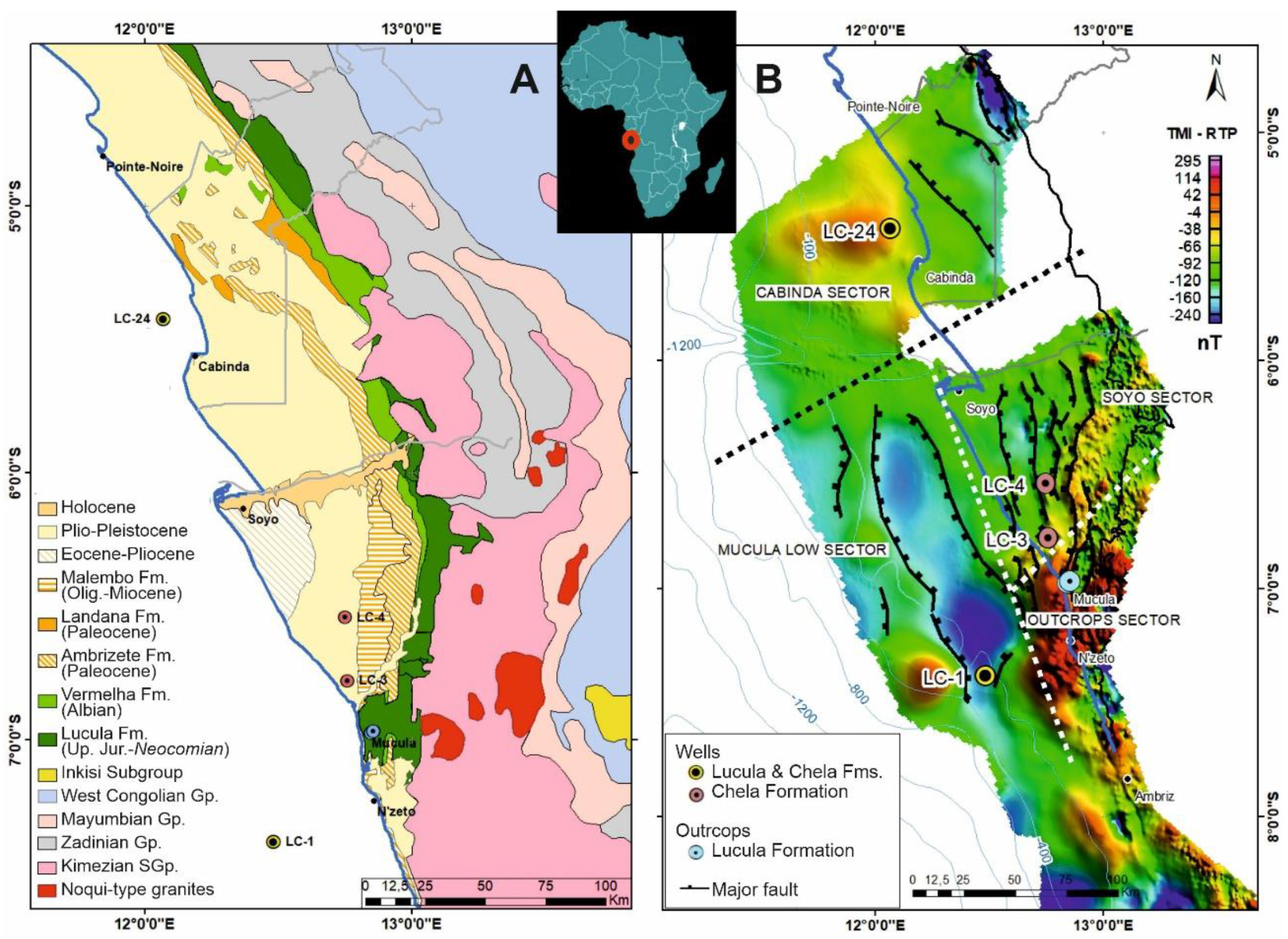
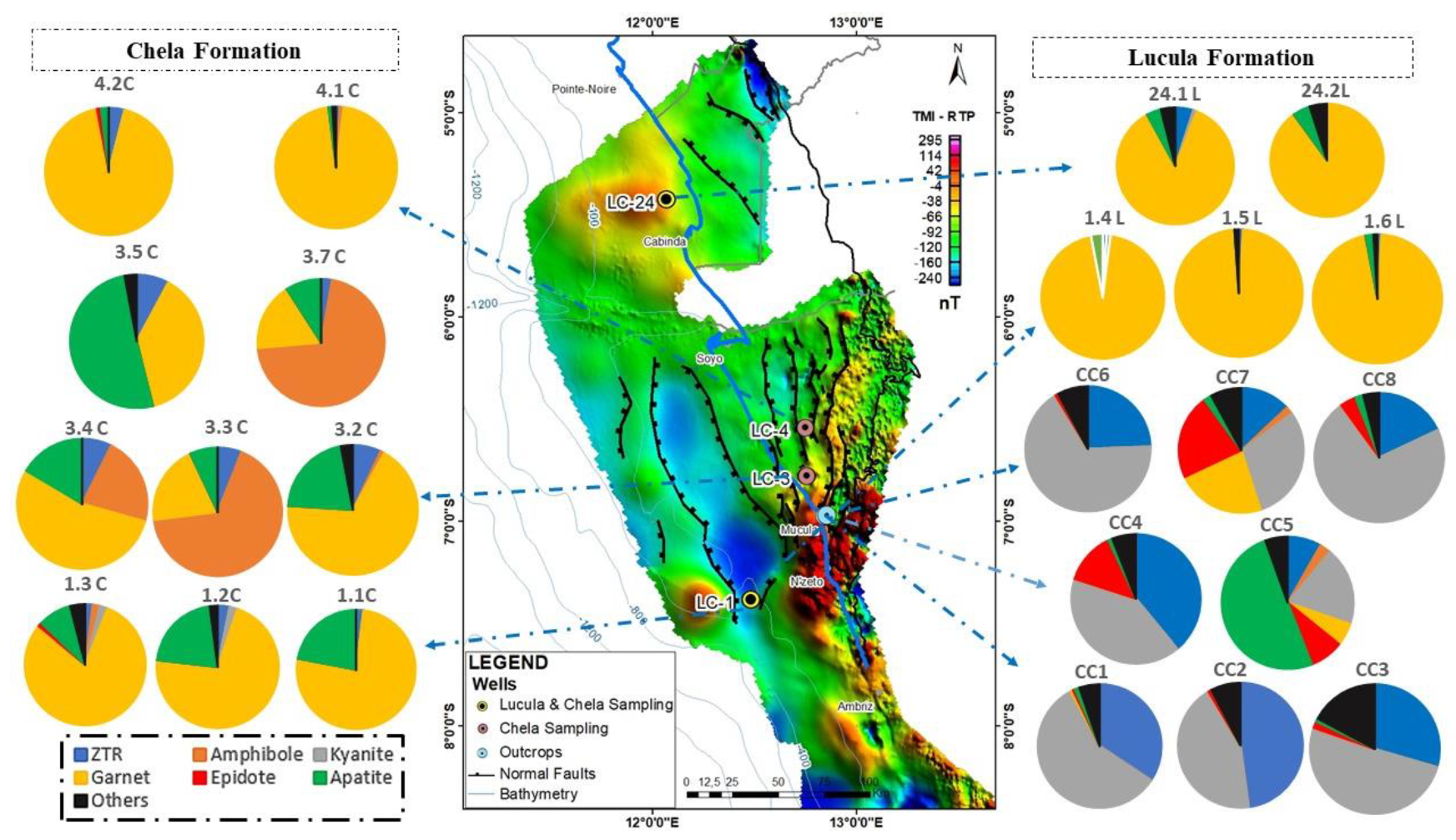
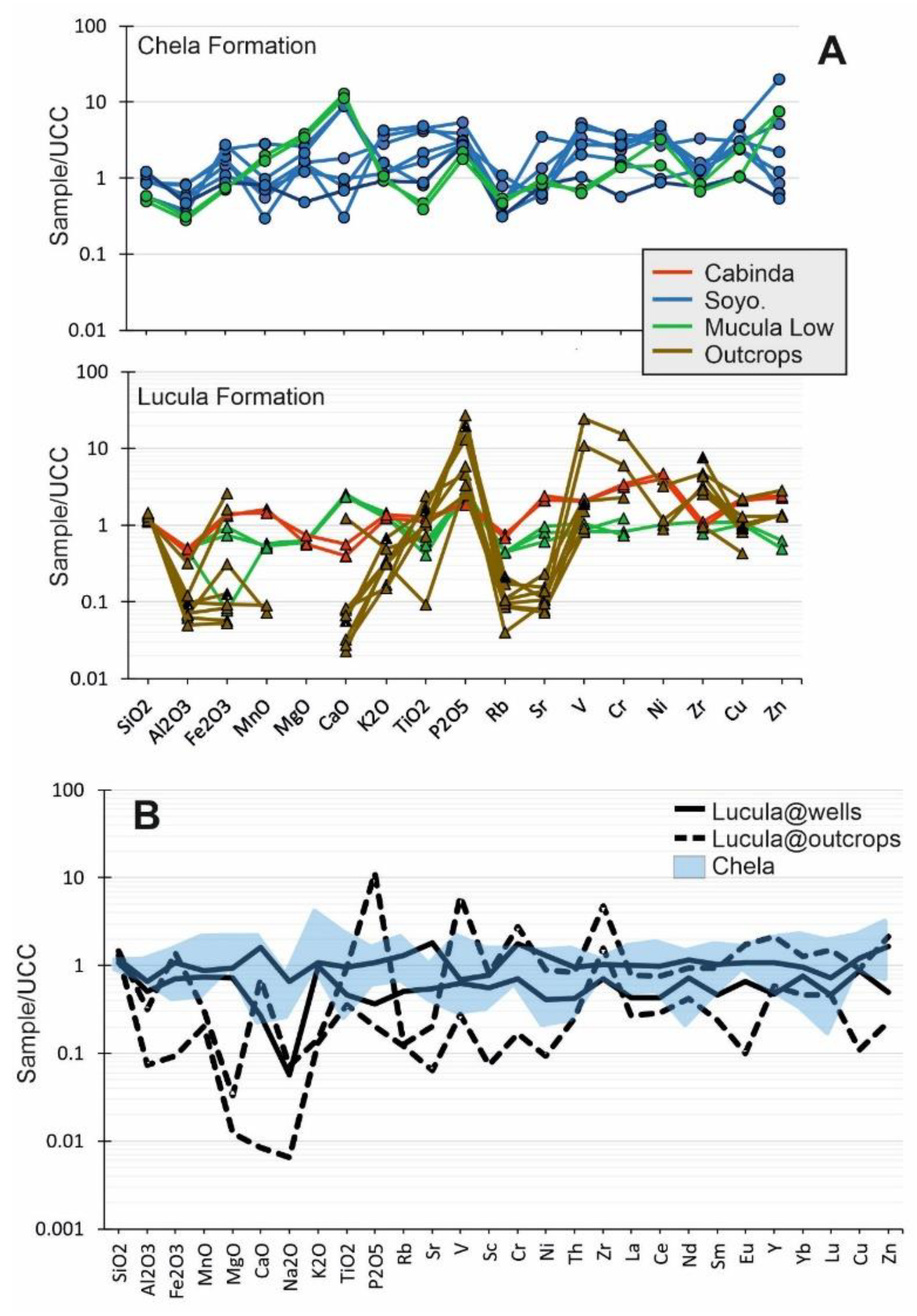
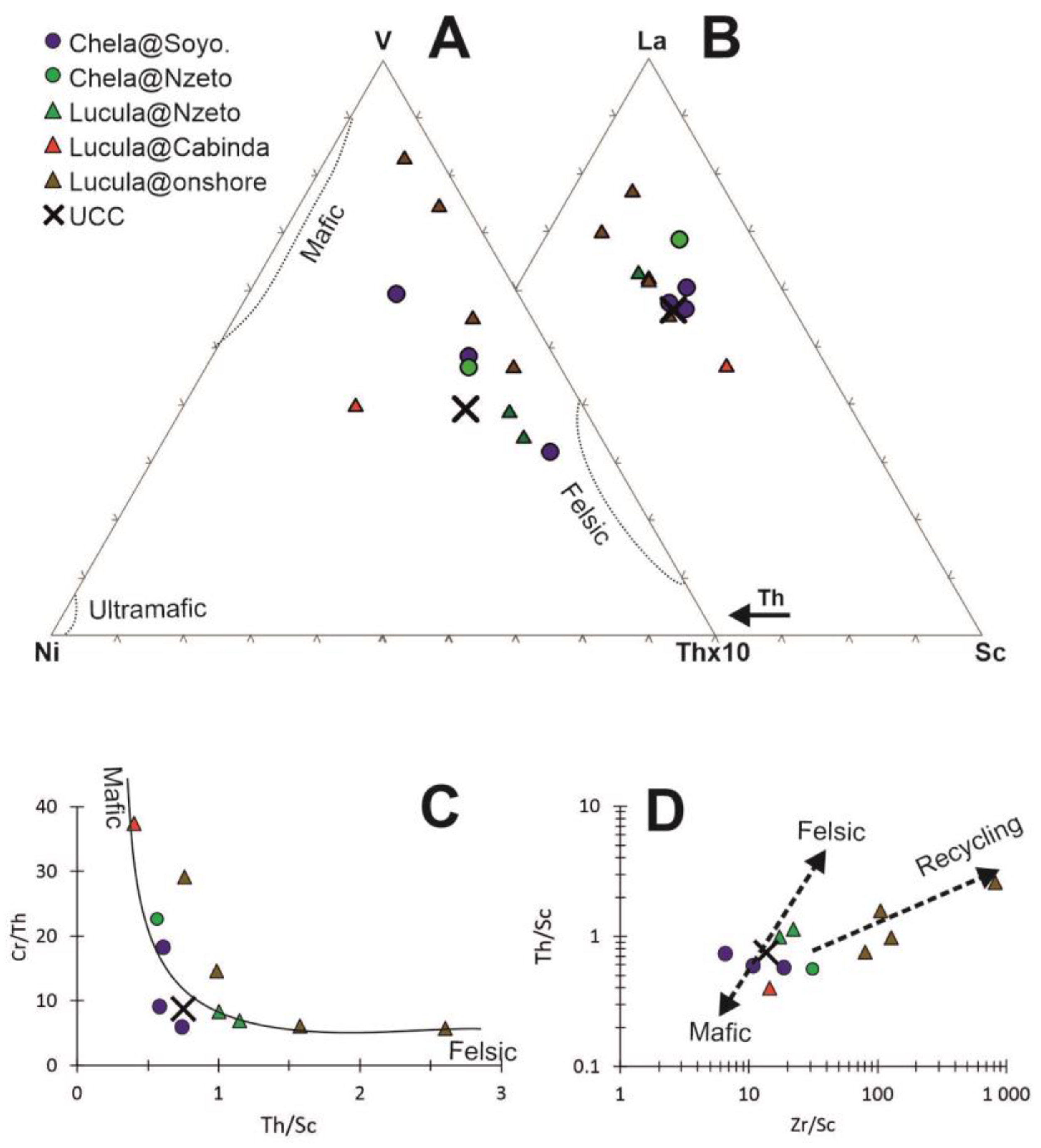
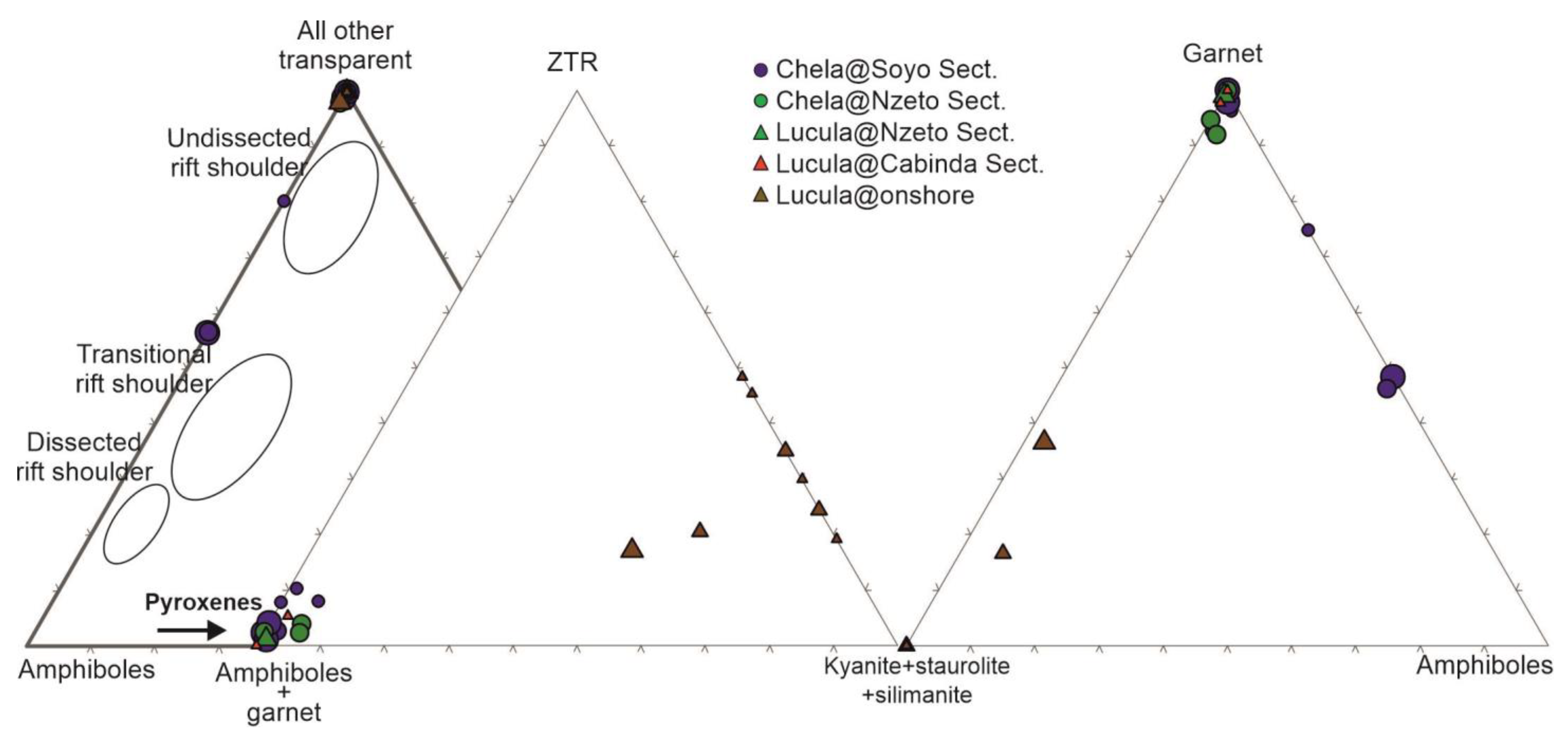

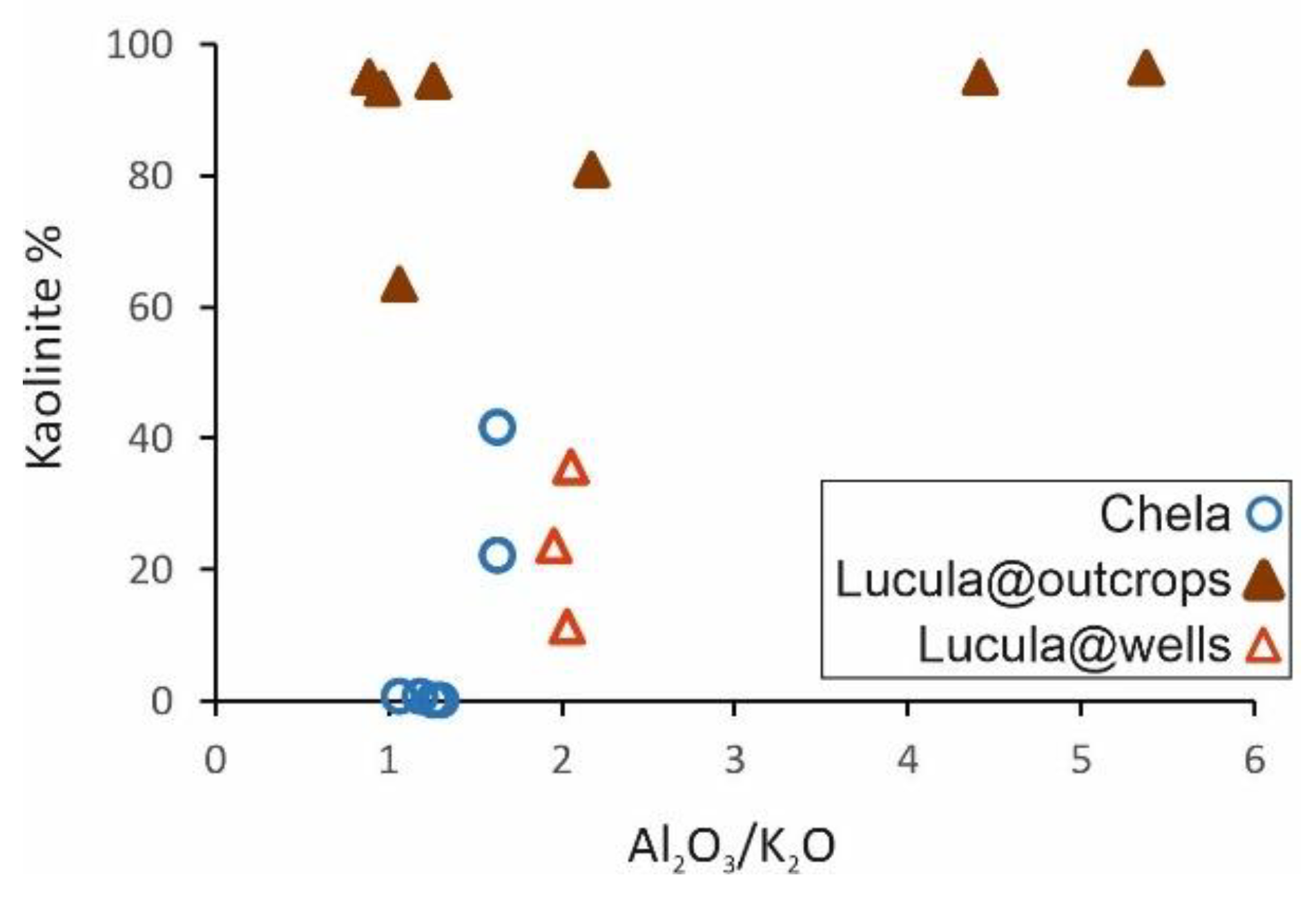
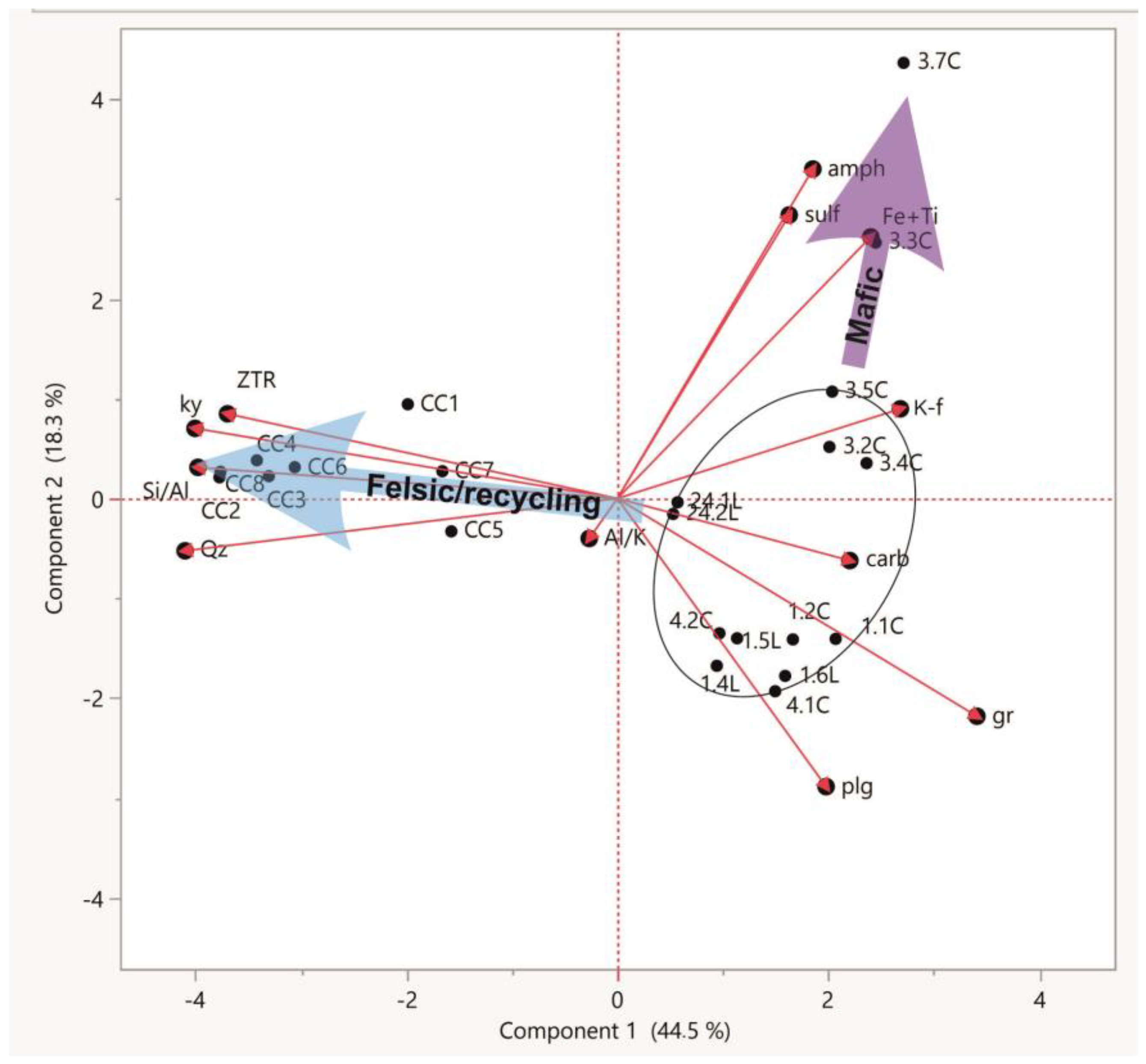
| Site | Sample | MGS | Fm. | Sector | Depth (m) |
|---|---|---|---|---|---|
| Well LC1 | 1.1C | CS (0.3) | Chela | Mucula Low | 3063.0 |
| Well LC1 | 1.2C | CS (0.9) | Chela | Mucula Low | 3081.0 |
| Well LC1 | 1.3C | CS (0.9) | Chela | Mucula Low | 3144.0 |
| Well LC1 | 1.4L | MS (1.2) | Lucula | Mucula Low | 3441.0 |
| Well LC1 | 1.5L | MS (1.1) | Lucula | Mucula Low | 3468.0 |
| Well LC1 | 1.6L | MS (1.4) | Lucula | Mucula Low | 3486.0 |
| Well LC3 | 3.2C | MS (1.5) | Chela | Soyo | 1288.0 |
| Well LC3 | 3.3C | MS (1.8) | Chela | Soyo | 1292.0 |
| Well LC3 | 3.4C | MS (1.7) | Chela | Soyo | 1292.0 |
| Well LC3 | 3.5C | MS (1.6) | Chela | Soyo | 1296.0 |
| Well LC3 | 3.7C | MS (1.5) | Chela | Soyo | 1313.5 |
| Well LC4 | 4.1C | CS (0.9) | Chela | Soyo | 1203.0 |
| Well LC4 | 4.2C | MS (1.1) | Chela | Soyo | 1205.0 |
| Well LC24 | 24.1L | FS (2.2) | Lucula | Cabinda | 3325.4 |
| Well LC24 | 24.2L | FS (2.3) | Lucula | Cabinda | 3325.4 |
| S4 | CC1 | MS (1.1) | Lucula | Outcrop | ~0 |
| S4 | CC2 | MS (1.4) | Lucula | Outcrop | ~0 |
| S2 | CC3 | MS (1.6) | Lucula | Outcrop | ~0 |
| S3 | CC4 | CS (0.5) | Lucula | Outcrop | ~0 |
| S1 | CC5 | MS (1.8) | Lucula | Outcrop | ~0 |
| S4 | CC6 | MS (1.5) | Lucula | Outcrop | ~0 |
| S2 | CC7 | MS (1.2) | Lucula | Outcrop | ~0 |
| S3 | CC8 | VCS (−0.7) | Lucula | Outcrop | ~0 |
| XRD Mineralogy | Heavy Minerals | |||||||||||||||||
|---|---|---|---|---|---|---|---|---|---|---|---|---|---|---|---|---|---|---|
| Sample | Fm. | Qz | K-F | Plg | Phyl | Carb | Sulf | Hal | Oth | %HM | ZTR | Gr | Ep | Amp | Ky | Sil | Ap | Oth |
| 1.1C | Chela | 15 | 13 | 11 | 6 | 53 | 2 | 0 | 0 | 1.61 | 2.0 | 76.0 | 0.0 | 0.0 | 0.0 | 0.0 | 22.0 | 0.0 |
| 1.2C | Chela | 28 | 19 | 13 | 4 | 35 | 0 | 0 | 1 | 1.40 | 3.2 | 71.6 | 0.0 | 0.0 | 2.1 | 1.1 | 21.1 | 1.1 |
| 1.3C | Chela | 1.04 | 2.0 | 80.0 | 1.0 | 2.0 | 2.0 | 0.0 | 9.0 | 4.0 | ||||||||
| 1.4L | Lucula | 49 | 14 | 11 | 17 | 7 | 1 | 0 | 1 | 1.57 | 1.0 | 95.0 | 0.0 | 0.0 | 1.0 | 0.0 | 3.0 | 0.0 |
| 1.5L | Lucula | 52 | 14 | 12 | 16 | 4 | 2 | 0 | 0 | 1.66 | 1.1 | 97.8 | 0.0 | 0.0 | 0.0 | 0.0 | 0.0 | 1.1 |
| 1.6L | Lucula | 37 | 15 | 18 | 18 | 12 | 0 | 0 | 0 | 3.37 | 1.0 | 96.0 | 0.0 | 0.0 | 0.0 | 0.0 | 2.0 | 1.0 |
| 3.2C | Chela | 6 | 55 | 0 | 29 | 9 | 0 | 1 | 0 | 0.55 | 6.4 | 68.2 | 0.0 | 0.9 | 1.8 | 0.9 | 20.0 | 1.8 |
| 3.3C | Chela | 13 | 58 | 0 | 29 | 0 | 0 | 0 | 0 | 3.39 | 1.9 | 40.9 | 0.0 | 43.5 | 0.0 | 0.0 | 13.6 | 0.0 |
| 3.4C | Chela | 19 | 28 | 18 | 17 | 13 | 3 | 1 | 1 | 0.27 | 6.6 | 58.2 | 0.0 | 19.7 | 0.0 | 0.0 | 15.6 | 0.0 |
| 3.5C | Chela | 11 | 20 | 0 | 20 | 35 | 13 | 0 | 1 | 0.61 | 6.0 | 50.7 | 0.0 | 1.3 | 0.0 | 0.7 | 40.0 | 1.3 |
| 3.7C | Chela | 9 | 9 | 0 | 31 | 12 | 39 | 0 | 0 | 1.32 | 2.2 | 38.9 | 0.0 | 43.3 | 0.0 | 0.0 | 13.9 | 1.7 |
| 4.1C | Chela | 41 | 10 | 23 | 14 | 0 | 0 | 7 | 5 | 4.35 | 1.0 | 96.0 | 0.0 | 1.0 | 0.0 | 1.0 | 1.0 | 0.0 |
| 4.2C | Chela | 44 | 10 | 12 | 9 | 0 | 1 | 19 | 5 | 6.01 | 4.0 | 93.0 | 1.0 | 0.0 | 0.0 | 0.0 | 2.0 | 0.0 |
| 24.1L | Lucula | 61 | 5 | 0 | 19 | 2 | 8 | 1 | 4 | 0.82 | 5.0 | 86.0 | 0.0 | 0.0 | 1.0 | 1.0 | 4.0 | 3.0 |
| 24.2L | Lucula | 75 | 0 | 0 | 16 | 1 | 8 | 0 | 0 | 0.60 | 0.0 | 90.0 | 0.0 | 0.0 | 0.0 | 0.0 | 6.0 | 4.0 |
| CC1 | Lucula | 81 | 1 | 3 | 10 | 0 | 0 | 0 | 5 | 1.12 | 34.3 | 0.6 | 0.6 | 0.0 | 58.0 | 3.0 | 1.2 | 2.4 |
| CC2 | Lucula | 96 | 2 | 2 | 0 | 0 | 0 | 0 | 5 | 0.57 | 47.9 | 0.0 | 0.9 | 0.0 | 43.6 | 3.4 | 0.0 | 4.3 |
| CC3 | Lucula | 97 | 2 | 0 | 1 | 0 | 0 | 0 | 5 | 0.77 | 29.5 | 0.0 | 1.6 | 0.0 | 50.8 | 11.5 | 0.8 | 5.7 |
| CC4 | Lucula | 99 | 1 | 0 | 0 | 0 | 0 | 0 | 0 | 0.48 | 39.0 | 0.0 | 13.0 | 0.0 | 41.0 | 3.0 | 1.0 | 3.0 |
| CC5 | Lucula | 85 | 5 | 5 | 1 | 0 | 0 | 0 | 4 | 2.39 | 15.3 | 5.5 | 8.3 | 2.8 | 24.3 | 1.8 | 40.5 | 3.7 |
| CC6 | Lucula | 94 | 4 | 0 | 2 | 0 | 0 | 0 | 0 | 2.19 | 24.4 | 0.0 | 0.8 | 0.0 | 66.9 | 0.8 | 0.0 | 7.3 |
| CC7 | Lucula | 99 | 0 | 0 | 0 | 0 | 0 | 0 | 1 | 3.56 | 13.0 | 23.0 | 22.0 | 2.0 | 30.0 | 7.0 | 2.0 | 1.0 |
| CC8 | Lucula | 97 | 2 | 0 | 1 | 0 | 0 | 0 | 0 | 0.16 | 18.0 | 0.0 | 4.0 | 0.0 | 72.0 | 0.0 | 2.0 | 4.0 |
Disclaimer/Publisher’s Note: The statements, opinions and data contained in all publications are solely those of the individual author(s) and contributor(s) and not of MDPI and/or the editor(s). MDPI and/or the editor(s) disclaim responsibility for any injury to people or property resulting from any ideas, methods, instructions or products referred to in the content. |
© 2025 by the authors. Licensee MDPI, Basel, Switzerland. This article is an open access article distributed under the terms and conditions of the Creative Commons Attribution (CC BY) license (https://creativecommons.org/licenses/by/4.0/).
Share and Cite
Constantino, J.; Dinis, P.A.; Gomes, R.S.; Mendes, M.M. Composition of Pre-Salt Siliciclastic Units of the Lower Congo Basin and Paleogeographic Implications for the Early Stages of Opening of the South Atlantic. Geosciences 2025, 15, 189. https://doi.org/10.3390/geosciences15050189
Constantino J, Dinis PA, Gomes RS, Mendes MM. Composition of Pre-Salt Siliciclastic Units of the Lower Congo Basin and Paleogeographic Implications for the Early Stages of Opening of the South Atlantic. Geosciences. 2025; 15(5):189. https://doi.org/10.3390/geosciences15050189
Chicago/Turabian StyleConstantino, João, Pedro A. Dinis, Ricardo Sousa Gomes, and Mário Miguel Mendes. 2025. "Composition of Pre-Salt Siliciclastic Units of the Lower Congo Basin and Paleogeographic Implications for the Early Stages of Opening of the South Atlantic" Geosciences 15, no. 5: 189. https://doi.org/10.3390/geosciences15050189
APA StyleConstantino, J., Dinis, P. A., Gomes, R. S., & Mendes, M. M. (2025). Composition of Pre-Salt Siliciclastic Units of the Lower Congo Basin and Paleogeographic Implications for the Early Stages of Opening of the South Atlantic. Geosciences, 15(5), 189. https://doi.org/10.3390/geosciences15050189








